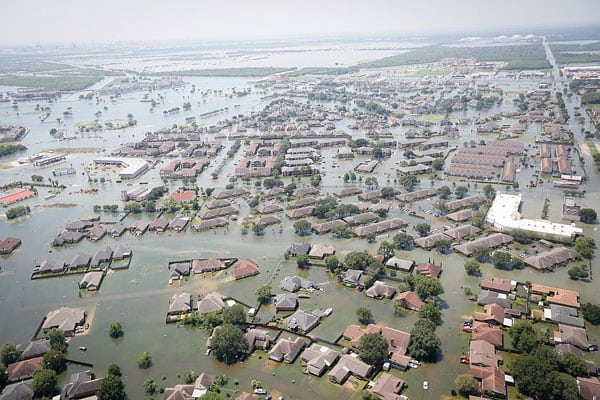
August 22, 2018; Texas Monthly
On August 25, 2017, Hurricane Harvey made landfall. Harvey, a Category-4 hurricane that dumped over 40 inches of rain in the region, killed 68 people and caused $125 billion in property damage. CNBC adds that, “Thirty-six of the deaths were in the low-lying Houston area, where days of torrential rainfall and decades of unchecked development contributed to the flooding of more than 150,000 homes and 300,000 vehicles.”
Mimi Schwartz writes in Texas Monthly that, “When the rain began easing up a few days later, the only part of downtown that seemed functional was the George R. Brown Convention Center.” Schwartz adds that, “Houston today can sometimes seem like a city struggling with a massive case of PTSD (post-traumatic stress disorder). When heavy rains are forecast…people think twice about getting in their cars.”
Recovery has been slow. Brandon Formby of the Texas Tribune, citing a Kaiser Family Foundation and Episcopal Health Foundation joint report, notes that, “One year after Hurricane Harvey slammed the Texas coast, eight percent of the people impacted by the disaster have not been able to return to their homes [and] 15 percent of the hundreds of thousands of homes damaged by the storm are still unlivable.” Formby adds that report also shows that, “Among black Texans impacted by the storm, 60 percent say they are not getting the help they need. That compares to 40 percent of [Latinx] respondents and 33 percent of white respondents.”
According to Charity Navigator, nonprofits raised “$742.6 million in ‘Harvey restricted’ funds from August 2017 to December 2017.” Chris Matthews of the Houston Business Journal notes that the same report indicated that, “An additional $13.7 million was donated more broadly, for ‘disaster/hurricane’ restricted funding…and $17.7 million was donated to be unrestricted in its use.” While nonprofits have been key players—and a few, notably the local Red Cross, faced criticism when they fell short—the federal government remains the dominant player. According to Adriana Navarro of AccuWeather, federal Harvey relief funds distributed in Texas to date exceed $26 billion—more than 30 times the amount distributed by nonprofits.
The recovery has upended cultural norms, as the federal role is begrudgingly acknowledged. Houstonians have tended to prefer to raise private dollars. “That works great for [capital campaigns for] hospitals and museums, but it doesn’t work for this. You have to have government action. The dollars are too big, the infrastructure issues too boring. No naming rights,” a resident informed Schwartz.
Sign up for our free newsletters
Subscribe to NPQ's newsletters to have our top stories delivered directly to your inbox.
By signing up, you agree to our privacy policy and terms of use, and to receive messages from NPQ and our partners.
Some important steps have been taken. “I think Harvey is the moment that could be the turning point for Houston,” Dale Morris, director of strategic partnerships for Water Institute for the Gulf, a Louisiana-based nonprofit, told Schwartz. “Something has changed.”
Last week, 85 percent of Houston-area voters cast their ballots in favor of a $2.5-billion bond measure to “fund projects that may include buyouts of homes in flood-prone areas, the expansion of local bayous and the construction of additional stormwater detention basins.” For Harris County (population 4.65 million) taxpayers, the cost works out to a modest average of $5 a year per household.
Flood control is one matter; helping those who have been dislocated by the storm get back on their feet is another. Presently, the city is deciding how to allocate $1.15 billion in funds from the US Department of Housing and Urban Development (HUD). Tom McCasland, Houston’s director of housing and community development, “wants residents of poor and working-class neighborhoods…to have a voice in how that money is spent, “says Schwartz. Schwartz adds that McCasland “hopes to put in place land trust programs that will limit who can build in certain neighborhoods and what they can charge for homes there, along with a voucher program that helps poor families live in areas with better schools.”
Preserving affordable housing is critical. As NPQ reported this week, federal disaster aid, in part because it supports homeowners, can widen the gap between haves and have-nots. Indeed, in Harris County itself, when disaster aid was last distributed, the wealth gap between whites and Blacks grew by $87,000 per household. If low-income communities and communities of color are not protected, similar results could be expected this time.
Another challenge is maintaining attention. Disaster recovery, Schwartz notes, takes time, but public attention is often short. “Once the immediate crisis is past, it’s difficult to keep the public invested.” Katie Olse, executive director of the Texas Alliance of Child and Family Services, described this to Governing as the “aftermath of the aftermath.”
As NPQ’s Martin Levine noted last September, “After immediate needs have been met and the sense of crisis is past, the storms’ longer-term effects remain, demanding continued resources and attention.” How Houston will do remains to be seen. “One year later, many of those with the fewest resources are still struggling to bounce back from Harvey’s punch,” cautioned Elena Marks, Episcopal Health Foundation president and CEO.—Steve Dubb











